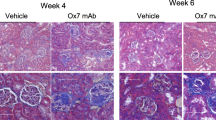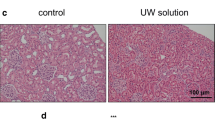Abstract
Ochratoxin A (OTA) is a widespread nephrotoxin which causes porcine nephropathy and is supposed to have caused the human Balkan endemic nephropathy. We performed experiments in vivo and in vitro to elucidate the mechanism of OTA action in renal epithelium. Application of OTA to male Wistar rats [1.25 μmol/ (kg · day)] for 6 days led to a reduction of glomerular filtration rate (to 63% of control), an increased fractional water (194% of control), Na+ (199% of control), K+ (147% of control) and Cl− (270% of control) excretion and an increased dependence of the osmole clearance on urine flow. Acute application of OTA to rats (3 μmol/ kg) increased urinary pH from 6.0±0.2 to 6.6±0.1 and urinary NaCl excretion, but decreased titratable acid excretion to 47% of control. As these in vivo findings may be the result of an action of OTA beyond the proximal tubule (“postproximal”) we investigated the effect of OTA on cultured Madin-Darby canine kidney (MDCK) cells, regarded as a model of collecting duct epithelium. In confluent monolayers formed by MDCK cells OTA reduced the number of domes in a dose-dependent manner and impaired the formation of a transepithelial Cl− gradient. Electrophysiological measurements in giant MDCK cells revealed that OTA blocks fractional anion conductance of the plasma membrane with an IC50 value of 30±5 nmol/l, unmasking OTA as a naturally occurring anion conductance blocker about 20-times more effective than the most potent synthetic blocker 5-nitro-2-(3-phenylpropyl-amino) benzoic acid (NPPB) (IC50=600±50 nmol/l). The effects of OTA and NPPB are not additive. We conclude that OTA acts acutely on “postproximal” parts of the nephron. This effect is probably located in the collecting duct and is due to its inhibitory action on plasma membrane anion conductance.
Similar content being viewed by others
References
Bauer J, Gareis M, Gedek B (1984) Zum Nachweis und Vorkommen von Ochratoxin A bei Schlachtschweinen. Berl Münch Tierärztl Wochenschr 97: 279–283
Berndt WO, Hayes AW (1979) In vivo and in vitro changes in renal function caused by ochratoxin A in the rat. Toxicology 12: 5–17
Creppy EE, Kern D, Steyn PS, Vleggaar R, Röschenthaler R, Dirheimer C (1983) Comparative study of the effect of ochratoxin A analogues on yeast aminoacyl-tRNA synthetases and on the growth and protein synthesis of hepatoma cells. Toxicol Lett 19: 217–224
Creppy EE, Röschenthaler R, Dirheimer G (1984) Inhibition of protein synthesis in the mice by ochratoxin-A and its prevention by phenylalanine. Food Chem Toxicol 22: 883–886
Creppy EE, Kane A, Giessen-Crouse E, Roth A, Röschenthaler R, Dirheimer G (1986) Effect of ochratoxin A on enzyme activities and macromolecules synthesis in MDCK cells. Arch Toxicol Suppl 9: 310–314
Galtier P, Charpenteau JL, Alvinerie M, Labouche C (1979) The pharmacokinetic profile of ochratoxin A in the rat after oral and intravenous administration. Drug Metab Dispos 7: 429–434
Gekle M, Silbernagl S (1993) The effect of ochratoxin A on renal hemodynamics. Pflügers Arch 422: R126
Gekle M, Oberleithner H, Silbernagl S (1992) The nephrotoxin ochratoxin A is a powerful Cl− channel blocker. J Am Soc Nephrol 3: 724
Gekle M, Oberleithner H, Silbernagl S (1992) Ochratoxin A blockiert Cl−-Kanäle: Ist diese Wirkung verantwortlich für seine Nephrotoxizität? Nieren-Hochdruckkr 9: 375–376
Gekle M, Silbernagl S, Löwe H (1992) Where in the kidney is ochratoxin A nephrotoxic? Renal Physiol Biochem 15: 197
Gekle M, Silbernagl S, Mildenberger S, Freudinger R (1993) Effect on dome formation and uptake of ochratoxin A in proximal tubule-derived Opossum kidney cell monolayers. Cell Physiol Biochem 3: 68–77
Hagelberg S, Hult K, Fuchs R (1989) Toxokinetics of ochratoxin A in several species and its plasma-binding properties. J Appl Toxicol 9: 91–96
Kersting U, Joha H, Steigner W, Gaßner B, Gstraunthaler G, Pfaller W, Oberleithner H (1988) Fusion of cultured dog kidney (MDCK) cells. I. Technique, fate of plasma membrane and cell nuclei. J Membr Biol 111: 37–48
Krogh P, Axelsen NH, Elling F, Gryd-Hansen N, Hald B, Hyldgaard-Jensen J, Larsen AE, Madsen A, Mortensen HP, Moller T, Petersen OK, Ravnskov U, Rostgaard M, Aalund O (1974) Experimental porcine nephropathy. Acta Pathol Microbiol Scand Sect A Pathol [Suppl] 246: 1–21
Krogh P, Hald B, Plestina R, Ceovic S (1977) Balkan (endemic) nephropathy and foodborn ochratoxin A: preliminary results of a survey of foodstuffs. Acta Pathol Microbiol Scand Sect B Microbiol 85: 238–240
Kuiper-Goodman T, Scott PM (1989) Risk assessment of the mycotoxin ochratoxin A. Biomed Environ Sci 2: 179–248
Mandal AK, Sindjic M, Sommers SC (1987) Kidney pathology in endemic nephrophathy. Clin Nephrol 27: 304–308
Meisner H (1976) Energy-dependent uptake of ochratoxin A by mitochondria. Arch Biochem Biophys 173: 132–140
Merwe KJ, Steyn PS, Fourie L, Scott DB, Theron JJ (1965) Ochratoxin A, a toxic metabolite produced by Aspergillus ochraceus Wilh. Nature 205: 1112–1113
van der Merwe KJ, Steyn PS, Fourie L (1965) Mycotoxins. II. The constitution of ochratoxin A, B and C metabolites of Aspergillus ochraceus Wilh. J Chem Soc Perkin Trans I: 7083–7088
NTP (1989) NTP technical report on the toxicology and carcinogenesis studies of ochratoxin A (CAS No. 303-47-9) in F344/N rats (Gavage studies). Research Triangle Park, NC. NHI Publication No. 89-2813. United States Department of Health and Human Services
Oberleithner H, Lang F, Messner G, Wang W (1984) Mechanism of hydrogen ion transport in the diluting segment of frog kidney. Pflügers Arch 402: 272–280
Oberleithner H, Kersting U, Silbernagl S, Steigner W, Vogel U (1989) Fusion of cultured dog kidney (MDCK) cells: II. Relationship between cell pH and K+ conductance in response to aldosterone. J Membr Biol 111: 49–46
Oberleithner H, Vogel U, Kersting U (1990) Madin-Darby canine kidney cells. I. Aldosterone-induced domes and their evaluation as a model system. Pflügers Arch 416: 526–532
Petkova-Bocharova T, Castegnaro M (1985) Ochratoxin A contamination of cereals in an area of high incidence of Balkan endemic nephropathy in Bulgaria. Food Addit Contam 2: 267–270
Sachs L (1984) Angewandte Statistik, 6th edn. Springer, Berlin Heidelberg New York
Sothell M, Karlmark B, Ulfendahl H (1983) FITC-inulin as a kidney tubule marker in rat. Acta Physiol Scand 119: 313–316
Stetson DL, Beauwens R, Palmisano J, Mitchell PP, Steinmetz PR (1985) A double-membrane model for urinary bicarbonate secretion. Am J Physiol 249: F546-F552
Tanner C, Frambach DA, Misfeldt DS (1983) Transepithelial transport in cell culture. A theoretical and experimental analysis of the biophysical properties of domes. Biophys J 43: 183–190
Tapia MO, Seawright AA (1984) Experimental ochratoxicosis A in pigs. Aust Vet J 61: 219–222
Valentich JD (1981) Morphological similarities between the dog kidney cell line MDCK and the mammalian cortical collecting tubule. Ann NY Acad Sci 372: 384–405
Wangemann P, Wittner M, Di Stefano A, Englert HC, Lang HJ, Schlatter E, Greger R (1986) Cl− channel blockers in the thick ascending limb of the loop of Henle. Structure activity relationship. Pflügers Arch 407: S128-S141
Author information
Authors and Affiliations
Additional information
With technical assistance of Ruth Freudinger and Sigrid Mildenberger.
Rights and permissions
About this article
Cite this article
Gekle, M., Oberleithner, H. & Silbernagl, S. Ochratoxin A impairs “postproximal” nephron function in vivo and blocks plasma membrane anion conductance in Madin-Darby canine kidney cells in vitro. Pflugers Arch. 425, 401–408 (1993). https://doi.org/10.1007/BF00374865
Received:
Revised:
Accepted:
Issue Date:
DOI: https://doi.org/10.1007/BF00374865




